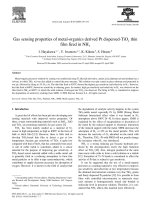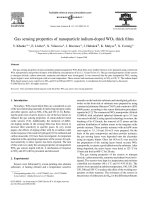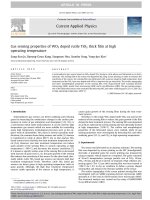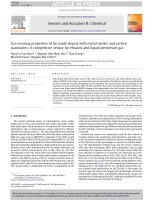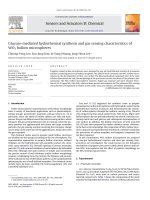- Trang chủ >>
- Khoa Học Tự Nhiên >>
- Vật lý
gas sensing properties of nanoparticle indium - doped wo3 thick films
Bạn đang xem bản rút gọn của tài liệu. Xem và tải ngay bản đầy đủ của tài liệu tại đây (521.9 KB, 7 trang )
Sensors and Actuators B 111–112 (2005) 45–51
Gas sensing properties of nanoparticle indium-doped WO
3
thick films
V. Khatko
a,∗
, E. Llobet
a
, X. Vilanova
a
, J. Brezmes
a
, J. Hubalek
b
, K. Malysz
b
, X. Correig
a
a
Department d’ Enginyeria Electronica, Campus Sescelades, Universitat Rovira i Virgili, 43007 Tarragona, Spain
b
Department of Microelectronics, Technical University of Brno, 60200 Brno, Czech Republic
Available online 11 August 2005
Abstract
The gas sensing properties of pure and indium-doped nanoparticle WO
3
thick films were studied. Sensors were prepared using commercial
WO
3
nanopowders and powder mixtures with different concentrations of In (1.5, 3.0 and 5.0wt.%). The gas sensing properties of the sensors
to nitrogen dioxide, carbon monoxide, ammonia and ethanol were investigated. It was observed that the pure nanoparticle WO
3
sensing
layers began to react with nitrogen oxide at room temperature. These sensors had maximum sensitivity to NO
2
at 100
◦
C. The indium-doped
WO
3
-based sensors were selective to NO
2
and CO at 200 and 300
◦
C, respectively. A mechanism for such behaviour is discussed.
© 2005 Elsevier B.V. All rights reserved.
Keywords: Pure and indium-doped tungsten oxide thick film; WO
3
gas sensor; Gas sensing properties
1. Introduction
Nowadays, WO
3
-based thick films are considered as one
of themostinteresting materials for detectingnitrogenoxides
and other species such as NH
3
,CH
4
and CO [1–6]. Reduc-
ing the grain size of active layers is one of the key factors to
enhance the gas sensing properties of semiconductor metal
oxide sensors [7,8]. Additionally, the inclusion of differ-
ent doping metals in the sensing films has been shown to
increase their sensitivity to specific gases. In very recent
papers, the effects of doping either with In or indium oxide
on the response of tin oxide to hydrogen [9,10], methanol and
carbon monoxide [11] have been investigated. An important
reduction in the operating temperature of the sensors for opti-
mal sensitivity to these species has been reported. The aim
of this work is to study the sensing properties of nanoparticle
WO
3
gas sensors doped with In. A mechanism of response
to NO
2
and CO will be presented and discussed.
2. Experimental
Sensors were fabricated by screen-printing onto alumina
substrates. A heating element and a temperature sensitive
∗
Corresponding author. Tel.: +34 977558653; fax: +34 977559605.
E-mail address: (V. Khatko).
meander on the backside substrate and interdigited gold elec-
trodes on the front side of substrate were prepared by using
commercial platinum (Heraeus C3657) and conductive (ESL
8884) pastes, according to the sensor fabrication procedures
reported in [12]. The commercial WO
3
nanopowder (Aldrich
55,008-6) with calculated spherical diameter up to 33.1 nm
was mixed with InCl
3
using special technology to ensure: the
breaking of In
Cl bonds, the removal of Cl atoms and the
uniform distribution of indium atoms in the tungsten oxide
powder mixture. Three powder mixtures with an In/W atom
ratio equal to 1.5, 3.0 and 5.0 wt.% were prepared. On the
basis of the pure nanopowder and these powder mixtures,
the gas sensing layers were deposited onto the electrodes
using an organic binder. Glass frit (4.9 wt.%) was used for
the preparation of the sensing layers based on pure WO
3
nanopowder, to ensure a good adhesion to the substrate. After
being deposited, the active layers were dried at 125
◦
C for
10 min and fired at 600
◦
C for 20 min.
The gas sensing properties of the sensors to nitrogen
dioxide, carbon monoxide, ammonia and ethanol were inves-
tigated. The sensors were kept in a temperature and moisture
controlled test chamber (40 ±1
◦
C and 41–43% R.H.). The
sensors were operated at ambient temperature, 100, 150, 200,
250, 300 and 350
◦
C to analyse the effect of the working tem-
perature on their response. The resistance of the sensors in
the presence of either pure air (R
air
) or the differentpollutants
0925-4005/$ – see front matter © 2005 Elsevier B.V. All rights reserved.
doi:10.1016/j.snb.2005.06.060
46 V. Khatko et al. / Sensors and Actuators B 111–112 (2005) 45–51
(R
gas
) at different concentrations was monitored and stored
in a PC.
The morphology of the sensing layers was determined by
JSM 6400 scanning electron microscope. In order to obtain
high-resolution SEM pictures and chemical element distri-
bution, the samples were coated with ultra thin gold and
carbon layers, respectively. The phase composition of the
sensing layers was determined by X-ray diffraction (XRD)
measurements using a Siemens D5000 diffractometer oper-
ated at 40 kV and 30mA with Cu K␣ radiation.
3. Results and discussion
3.1. Gas sensitivity studies
For the first set of experiments, the sensing layers based
on pure tungsten oxide nanopowders were used. The WO
3
sensors were operated in a working temperature range from
room temperature to 350
◦
C. The gas sensing properties of
the sensors to nitrogen dioxide and carbon monoxide were
investigated. WO
3
sensors did not change resistance signifi-
cantly during their exposure to increasing CO concentrations
up to 500 ppm, throughout the temperature range studied.
The sensor response of these sensors to nitrogen dioxide had
definite features. Fig. 1 shows the influence of the presence
of glass frit on the response of un-doped tungsten oxide sen-
sors to nitrogen dioxide. It can be seen that the sensors began
to react with gas at room temperature (Fig. 1a). At 1ppm
of NO
2
the responsiveness calculated using the expression
S =(R
gas
− R
air
)/R
air
is shown in Table 1 as a function of the
sensor working temperature. In the temperature range from
room temperature to 150
◦
C the sensors with glass frit (WO
2
3
)
show a higher response to nitrogen dioxide than the sensors
without glass frit (WO
1
3
) (see Fig. 1b and c). Furthermore,
the response of the former is much faster than the response
of the latter. At working temperatures higher than 150
◦
C the
sensor resistance increases monotonously (Fig. 1d) and the
sensitivity to nitrogen dioxide decreases.
In a second set of experiments, the level of In doping
in the response of tungsten oxide based sensors to nitrogen
dioxide and carbon monoxide was investigated. The sensors
were operated in a temperature range from 150 to 350
◦
C.
Figs. 2 and 3 show the effects of indium concentration in the
detection of nitrogen dioxide and carbon monoxide, respec-
Table 1
Responsiveness of pure nanopowder WO
3
sensing layers to NO
2
(1 ppm) as
a function of the working temperature and thick film composition
Thick film composition Working temperature
Room temperature 100 (
◦
C) 150 (
◦
C)
WO
1
3
0.276 3.4 –
WO
2
3
– 18.47 0.218
Super-indexes 1 and 2 are for tungsten oxide films without and with glass
frit, respectively.
Fig. 1. Responses to nitrogen dioxide of pure WO
3
sensors without (WO
1
3
)
and with (WO
2
3
) glass frit in the paste, operated at room temperature (a),
100
◦
C (b), 150
◦
C (c) and 200
◦
C (d).
V. Khatko et al. / Sensors and Actuators B 111–112 (2005) 45–51 47
Fig. 2. Responses to nitrogen dioxide of indium-doped WO
3
sensors with
indium concentrations of 1.5 wt.% (WIn
1
), 3.0 wt.% (WIn
2
) and 5.0 wt.%
(WIn
3
), operated at 150
◦
C (a) and 200
◦
C (b).
tively. The In-doped WO
3
sensors were more sensitive to
NO
2
when operated at 200
◦
C and more sensitive to CO
when operated at 300
◦
C. The sensors showed the highest
responsiveness to NO
2
when indium concentration was set at
3.0 wt.%. When operated at 200
◦
C in the presence of 1ppm
of NO
2
, the responsiveness of the In-doped tungsten oxide
sensors was 0.144, 0.347 and 0.188 for indium concentra-
tions of 1.5 wt.% (sensor labelled WIn
1
), 3.0 wt.% (WIn
2
)
and 5.0wt.% (WIn
3
), respectively. Fig. 3 shows that only
the sensors (WIn
3
), i.e., doped with In at a level of 5wt.%
responded to CO. This responsiveness was up to 0.137.
In a third set of experiments the response of the differ-
ent sensors to ethanol and ammonia was investigated. The
working temperature range varied from 100 to 300
◦
C. The
sensors showed response to ethanol at temperatures higher
than 200
◦
C. Fig. 4 shows the response sensor to ethanol as a
function of the concentration of indium in the sensing layers,
when operatedat 300
◦
C. Itcan be seenthata saturation effect
in sensor response takes place at 10 ppm of ethanol. Subse-
quentinjectionsofethanolto increaseits concentrationto 100
Fig. 3. Responses to carbon monoxide of indium-doped WO
3
sensors with
indium concentrations of 1.5 wt.% (WIn
1
), 3.0 wt.% (WIn
2
) and 5.0 wt.%
(WIn
3
), operated at 250
◦
C (a) and 300
◦
C (b).
Fig. 4. Responses to ethanol of indium-doped WO
3
sensors with indium
concentrations of 1.5 wt.% (WIn
1
), 3.0 wt.% (WIn
2
) and 5.0 wt.% (WIn
3
),
operated at 300
◦
C.
48 V. Khatko et al. / Sensors and Actuators B 111–112 (2005) 45–51
Table 2
Responsiveness of In doped WO
3
sensing layers to ethanol (10 ppm) as a
function of the working temperature and thick film composition
Thick film composition Working temperature (
◦
C)
200 250 300
WIn
1
0.677 0.8 0.723
WIn
2
0.477 0.898 0.845
WIn
3
0.761 0.901 0.874
WIn
1
,WIn
2
and WIn
3
correspond to indium doping levels of 1.5, 3 and
5 wt.%, respectively.
and 500 ppm did not essentially change the resistance of the
sensing layers. The responsiveness of the differently doped
sensors to ethanol as a function of their working temperature
isshowninTable2.Thesensorswithanindiumconcentration
of 5.0 wt.% showed the highest responsiveness when oper-
ated at 250
◦
C. The sensor response to ammonia follows an
involved pattern (see Fig. 5). The resistance of the different
sensing layers increased when 10 or 100 ppm of ammonia
were injected into the test chamber, and decreased sharply
when ammonia concentration was increased to 500ppm.
3.2. Structural characterisation
SEM and XRD investigations were used to explain the
experimental results obtained. Fig. 6 shows the surface
(Fig. 6a) and the morphology of the pure WO
3
thick film
(Fig. 6b) and In doped (5 wt.%) WO
3
thick film (Fig. 6c)
sensing layers. It can be seen that the film surface (Fig. 6a)
shows a large quantity of cracks. It is assumed that crack for-
mation is related to the high (up to 80
◦
C/min) temperature
increase rate at the initial stage of firing. The average gran-
ule size in the pure WO
3
sensing layers was up to 60 nm
(Fig. 6b). The morphology of the In doped sensing layer
did not depend on indium concentration. The tungsten oxide
layers were nanoparticular with average granule size around
Fig. 5. Responses to ammonia of indium-doped WO
3
sensors with indium
concentrations of 1.5 wt.% (WIn
1
), 3.0 wt.% (WIn
2
) and 5.0 wt.% (WIn
3
),
operated at 300
◦
C.
Fig. 6. SEM images of a pure WO
1
3
thick film surface (a, b) and indium-
doped WO
3
thick film with indium concentration of 3 wt.%
70 nm and had uniform granule distribution (Fig. 6c). It can
be seen that the morphology of the pure and In doped WO
3
sensing layers is almost identical. There is just a small dif-
ference in the average granule size.
XRD data showed that two monoclinic phases (JCPDS
cards no. 83-0950 and 87-2386) are present in the com-
mercial WO
3
nanopowders. Two monoclinic phases are
described in the P2
1
/n (JCPDS cards no. 83-0950) and
Pc (JCPDS cards no. 87-2386) space with cell param-
V. Khatko et al. / Sensors and Actuators B 111–112 (2005) 45–51 49
Fig. 7. XRD patterns fromWO
3
nanopowders,and pure (WO
1
3
) and indium-
doped WO
3
thick films (WIn
2
and WIn
3
).
eters a = 7.3008, b =7.5389, c = 7.6896, β = 90.892
◦
and
a =5.2771, b=5.1569, c= 7.666, β = 91.742
◦
, respectively.
Fig. 7 presents the XRD patterns from 2θ =22
◦
to 25
◦
of
WO
3
nanopowder, both pure and In-doped WO
3
thick films.
The XRD patterns contain (20 0), (020) and (0 02) reflec-
tions of the monoclinic phase described in the P2
1
/n space
and (1 1 0) reflection of another monoclinic phase. After the
firing process, the sensing layers had mainly the first mon-
oclinic phase described in the P2
1
/n space. The presence of
metallic indium and indium oxide phase was not detected by
the XRD method. On the basis of this result, we can suggest
that In
3+
ions were able to diffuse into the tungsten oxide
lattice at the firing temperature used. This fact is confirmed
indirectly. The basic X-ray lines in the X-ray spectrum show
a shiftfromthe standard position thatincreaseswhen the con-
centration of indium is increased (see Fig. 7). The crystallite
size in the WO
3
nanopowder, and in pure and In-doped WO
3
thick films was evaluated from the diffraction line of (00 2)
Table 3
Chemical element distribution in the indium-doped WO
3
thick films
Indium concentration in
WO
3
thick films (wt.%)
Chemical elements
O In W In/W (%)
1.5 15.81 1.11 83.08 1.34
3.0 14.54 2.08 83.39 2.49
5.0 14.03 3.81 83.43 4.57
based on the Scherrer equation [13].
D
hkl
=
0.9λ
β
hkl
cos(θ
hkl
)
(1)
where λ is wavelength of the incident radiation, β
hkl
the full
width at half-maximum(FWHM)of the peak in the radiation,
and θ
hkl
the Bragg angle.Theaverage crystallitesizeofWO
3
nanopowder and pure WO
3
thick film is 30.4 and 45.5 nm,
respectively. In In-doped WO
3
thick films this parameter
is 49.0nm (1.5 wt.% In), 43.6nm (3 wt.% In) and 43.0 nm
(5 wt.% In).
An analysis of the chemical element distribution in the
sensing layers obtained by energy-dispersive X-ray spec-
troscopy (EDX) confirmed the absence of chlorine atoms
into the sensing layers. Fig. 8 shows the chemical element
distribution into the In-WO
3
sensors with an indium concen-
tration up to 3wt.% obtained by EDX. It can be seen that
tungsten, indium and oxygen atoms are the only constituents
of the sensing layer. Estimation of the In/W ratio in the tung-
sten oxide films doped with indium performed on the basis of
EDX data were in good agreement with the designed indium
concentrations of 1.5, 3 and 5wt.%. These results are sum-
marised in Table 3.
3.3. Discussion
The data obtained from the first set of experiments show
that the high response of pure WO
3
sensing layers (even at
Fig. 8. Chemical element distribution in the indium-doped WO
3
sensor with indium concentration of 3 wt.%
50 V. Khatko et al. / Sensors and Actuators B 111–112 (2005) 45–51
very low temperature) is most likely due to the small grain
size and the high surface area of these nanopowder films.
The surface layer of nanogranules has a non-stoichiometric
structure, which contains oxygen vacancies that behave as
traps for electrons.
The sensing properties of pure WO
3
thick films are con-
trolled by their surface defects and structure. A probable rea-
son for the high responsiveness to nitrogen dioxide shown by
pure tungsten oxide films at 100
◦
C is the desorption of O
2
−
[14]species.NO
2
replacesthedesorbed oxygenspeciesat the
surface of the WO
3
thick films, which causes a sharp growth
in their resistance. Increasing the working temperature of the
sensorschangesthe equilibriumof the adsorption–desorption
reaction with NO
2
. The decrease in the number of active
adsorption sites when the temperature of the sensor is raised
causes a reduction of the sensor response to NO
2
at work-
ing temperatures higher than 100
◦
C. The addition of glass
frit increases sensor sensitivity because of the presence of
different metal oxide additives.
Thefiringprocess undergoneby pureor In-dopedtungsten
oxide films at 600
◦
C does not dramatically increases particle
size nor promotes the growth of crystallites. Furthermore,
particle size of pure or In-doped films is almost identical due
to the fact that indium diffuses into the tungsten oxide lattice.
The sensitivity of indium-doped sensors operated at 200
and 300
◦
CtoNO
2
and CO is determined by the defects
generated by the inclusion of indium impurities. During the
preparation of powder mixtures and the firing process, In
3+
ions generated from the breaking of In
Cl bonds can diffuse
into the tungsten oxide lattice and form there an additional
number of new defects. On the basis of XRD data it can
be derived that these defects are substitutional defects, since
the interplanar spacing of the WO
3
crystal lattice decreases
when the concentration of indium impurities is increased.
Correspondingly, new energetic levels related to the presence
of indium atoms are generated in the band gap of the In-
loaded WO
3
. These energetic levels are the source of added
support of charge that changes the sensing properties of the
WO
3
-based sensors.
4. Conclusions
The gas sensing properties of pure and indium-doped
nanoparticle WO
3
thick films were studied. Sensors were
prepared using commercial WO
3
nanopowders and pow-
der mixtures with different concentrations of In (1.5, 3.0
and 5.0wt.%). Their response to different concentrations of
nitrogen dioxide, carbon monoxide, ammonia and ethanol
were investigated. It was found that the pure WO
3
sensors
responded to nitrogen dioxide even when operated at room
temperature. These sensors showed a maximum sensitivity
to NO
2
when working at 100
◦
C. The fact that pure WO
3
sensing layers show response to NO
2
at low temperatures is
due to the small grain size and high surface area of the WO
3
nanopowders. Indium-doped WO
3
sensors were selective to
NO
2
and CO when operated at 200 and 300
◦
C, respectively.
In this case, the selectivity of the sensors is determined by
the defects generated by indium impurities.
Acknowledgement
The authorsthank Dr. FrancescGuirado(URV,Tarragona)
for performing the XRD measurements on the WO
3
thick
films.
References
[1] P. Shaver, Activated tungsten oxide gas detectors, Appl. Phys. Lett.
11 (1967) 255–257.
[2] D.G. Dwyer, Surface chemistry of gas sensors: H
2
SonWO
3
films,
Sens. Actuators B 5 (1991) 155–159.
[3] A.A. Tomchenko, V.V. Khatko, I.L. Emelianov, WO
3
thick films gas
sensor, Sens. Actuators B 46 (1998) 8–14.
[4] A.A. Tomchenko, I.L. Emelianov, V.V. Khatko, Tungsten trioxide-
based thick-film NO sensor: design and investigation, Sens. Actuators
B 57 (1999) 166–170.
[5] Y.K. Chung, M.H. Kim, W.S. Um, H.S. Lee, J.K. Song, S.C. Choi,
K.M. Yi, M.J. Lee, K.W. Chung, Gas sensing properties of WO
3
thick film for NO
2
gas dependent on process condition, Sens. Actu-
ators B 60 (1999) 49–56.
[6] D.S. Lee, S.D. Han, J.S. Huh, D.D. Lee, Nitrogen oxides-sensing
characteristics of WO
3
-based nanocrystalline thick film gas sensor,
Sens. Actuators B 60 (1999) 57–63.
[7] I. Jimenez, J. Arbiol, G. Dezanneau, A. Cornet, J.R. Morante, Crys-
talline structure, defects and gas sensor response to NO
2
and H
2
S
of tungsten trioxide nanopowders, Sens. Actuators B 93 (2003)
343–351.
[8] S H. Wang, T C. Chou, C C. Liu, Nano-crystalline tungsten oxide
NO sensor, Sens. Actuators B 94 (2003) 475–485.
[9] S. Shukla, S. Seal, L. Ludwig, C. Parish, Nanocrystalline indium
oxide-doped tin oxide thin film as low temperature hydrogen sensor,
Sens. Actuators B 97 (2004) 256–265.
[10] S. Shukla, L. Ludwig, C. Parrish, S. Seal, Inverse-catalyst-effect
observed for nanocrystalline-doped tin oxide sensor at lower operat-
ing temperatures, Sens. Actuators B 104 (2005) 223–231.
[11] A. Salehi, M. Gholizade, Gas-sensing properties of indium-doped
SnO
2
thin films with variations in indium concentration, Sens. Actu-
ators B 89 (2003) 173–179.
[12] J. Hub
´
alek, K. Malysz, J. Pr
´
a
ˇ
sek, X. Vilanova, P. Ivanov, E. Llobet,
J. Brezmes, X. Correig, Z. Sv
ˇ
er
´
ak, Pt-loaded Al
2
O
3
catalytic filters
for screen-printed WO
3
sensors highly selective to benzene, Sens.
Actuators B 101 (2004) 277–283.
[13] B.D. Cullity, Elements of X-ray Diffraction, 2nd ed., Addison Wes-
ley, MA, USA, 1978, p. 127.
[14] I.A. Myasnikov, V.Ya. Sucharev, L.Yu. Kupriyanov, S.A. Zavialov,
Semiconductor Sensors in Physicochemical Investigations, Nauka,
Moscow, Russia, 1991, p. 327.
Biographies
Viacheslav Khatko graduated in nuclear physics from the Byelorussian
State University (Minsk, Belarus) in 1971. He received his PhD in mate-
rial science in 1985 and Dr.Sc. in electronic engineering in 2001. In
1975–2003 he worked at the Physical Technical Institute of National
Academy of Sciences of Belarus, Minsk, as a researcher, head of the
V. Khatko et al. / Sensors and Actuators B 111–112 (2005) 45–51 51
Laboratory of Electronic Engineering Materials, head of the Thin Film
Materials Department and then as Principal Investigator of the insti-
tute. He was Ford SABIT Intern and Ford Visiting Scientist in 1998
and 1999, respectively. From April 2003 he is Ram
´
on y Cajal profes-
sor in the Electronic Engineering Department at the Universitat Rovira
i Virgili (Tarragona, Spain). His current research interests include the
development and application of semiconductor thin and thick film gas
sensors.
Eduard Llobet graduated in telecommunication engineering from the
Universitat Polit
`
ecnica de Catalunya (UPC), (Barcelona, Spain) in 1991,
and received his PhD in 1997 from the same university. During 1998,
he was a visiting fellow at the School of Engineering, University of
Warwick (UK). He is currently an associate professor in the Electronic
Engineering Department at the Universitat Rovira i Virgili (Tarragona,
Spain). His main areas of interest are in the fabrication, and modelling,
of semiconductor chemical sensors and in the application of intelligent
systems to complex odour analysis. Dr. Llobet is a member of the Institute
of Electrical and Electronic Engineers.
Xavier Vilanova graduated in telecommunication engineering from the
Universitat Polit
`
ecnica de Catalunya (UPC), (Barcelona, Spain) in 1991,
and received his PhD in 1998 from the same university. He is currently
an associate professor in the Electronic Engineering Department at the
Universitat Rovira i Virgili (Tarragona, Spain). His main areas of interest
are in semiconductor chemical sensors modelling and simulation.
Jes
´
us Brezmes graduated in telecommunication engineering from the
Universitat Polit
`
ecnica de Catalunya (UPC), (Barcelona, Spain) in 1993.
Since 1993, he has been a Ph.D. student in the Signal Processing and
Communications Department at the same university. He has been a lec-
turer in the Electronic Engineering Department at the Universitat Rovira
i Virgili (Tarragona, Spain) since 1994. His main area of interest is in
the application of signal processing techniques such as neural networks
to chemical sensor arrays for complex aroma analysis.
Jaromir Hubalek graduated in electronic devices and systems from Brno
University of Technology (Czech Republic) in 1996. Since 1996 he has
been a PhD student at the Microelectronics Department at Brno University
of Technology and received his PhD in 2003 from the same university.
His work is focused on precise conductivity detector using planar comb
electrodes. Since 2000 he has worked in thick-film sensors fabrication at
the Electronic Engineering Department at the Universitat Rovira i Virgili
(Tarragona, Spain).
Karel Malysz graduated in Materials Engineering at University of Par-
dubice, faculty of Chemistry and Chemical Technology in 2000. Since
2000 he has been a PhD student at the Department of Microelectronics,
Brno University of Technology (Brno, Czech republic). His work focuses
on the preparation of new types of semiconductor gas sensors and gas
sensing materials.
Xavier Correig graduated in telecommunication engineering from the
Universitat Polit
`
ecnica de Catalunya (UPC), (Barcelona, Spain) in 1984,
and received his PhD in 1988 from the same university. He is a full
professor of Electronic Technology in the Electronic Engineering Depart-
ment at the Universitat Rovira i Virgili (Tarragona, Spain). His research
interests include heterojunction semiconductor devices and solid-state gas
sensors. Dr. Correig is a member of the Institute of Electrical and Elec-
tronic Engineers.


